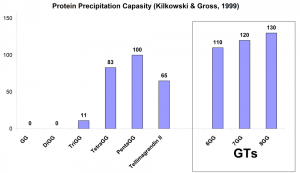Protein affinity is the most traditional of the tannin-related activities and the main structural reasons for high and low activities are quite well known although further knowledge in this area is needed as well
 Tannins in general show relatively high protein affinities, since they typically are the largest compounds of the polyphenol family, thus having the highest number of phenolic hydroxyl groups available for hydrogen bond formation between a tannin and protein. For this reason it is not a surprise that the smallest galloylglucoses have negligible protein precipitation capacity as practically four galloyl groups are needed to achieve a significant PPC value (see figure). Logically, the PPC tends to get higher as the number of galloyl groups increases. However, as soon as the flexible galloyl groups are attached together to form HHDP groups of ellagitannins, the PPC of the resulting compound decreases due to restricted conformational flexibility of the HHDP vs. two galloyl groups.
Tannins in general show relatively high protein affinities, since they typically are the largest compounds of the polyphenol family, thus having the highest number of phenolic hydroxyl groups available for hydrogen bond formation between a tannin and protein. For this reason it is not a surprise that the smallest galloylglucoses have negligible protein precipitation capacity as practically four galloyl groups are needed to achieve a significant PPC value (see figure). Logically, the PPC tends to get higher as the number of galloyl groups increases. However, as soon as the flexible galloyl groups are attached together to form HHDP groups of ellagitannins, the PPC of the resulting compound decreases due to restricted conformational flexibility of the HHDP vs. two galloyl groups.
The same pattern continues as further HHDP or NHTP groups are formed from the galloyls. In addition to the loss of flexibility, this is believed to be related to the increased hydrophilicity of the tannins. Further investigations on this issue are ongoing.
